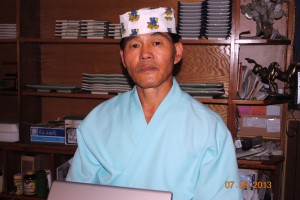Tokyo Sushi: Tong Kim Fuses Japanese and Korean in the bluegrass
Text and Photos by: David Hicks

Tucked away between a Gamers store and a pizza place on 115 North Locust Hill Drive is a small piece of Nirvana. I imagine that Tokyo Sushi is a bit like walking into one of the wonderful food establishments on a busy Asian city street. You’ll be greeted by the smiling face of Tong Kim (TK) the owner and Sushi Chef of Tokyo Sushi. Next, you are usually greeted and seated by Daehwan Kim, TK’s son and the greeter/server. Daehwan has a wealth of knowledge about the menu items and is always happy to answer any questions. That can come in handy when you are looking at a menu that covers both Japanese and Korean dishes. From behind the curtain, you’ll occasionally catch glimpses of a woman darting hurriedly back and forth preparing Tokyo Sushi’s Korean dishes. That’s Okhee Kim, TK’s wife.
TK and his family first moved to the United States by way of New York City. Daehwan came to Lexington to attend college and fell in love with our great city. Daehwan told his parents about how much he enjoyed living here and about the lower cost of living and doing business and soon they too moved to Lexington. TK studied under Mr. Fuji a Master Sushi Chef in New York City before the move.

From Sashimi to Nigiri, to rolls and handrolls, TK makes them all. They receive their sushi fresh three times weekly and do not serve it after two days. Because of this, you may be able to get a tuna or salmon collar on any given day, just ask. Thrown away in America, the collar is one of the most the most highly flavored cuts of fish due to its higher fat content.
Cold and a little more thickly cut than sushi, the sashimi is served on top of julienned Daikon Radish. Yellow Tail and Squid are two of my favorites here. Many of the special rolls are designed by and named after patrons. Customers come and go but Patrons are more special and plentiful here from my observations over multiple visits. The Japanese Lasagna has a generous filling of Masago (flying fish roe), crab, and avocado. This is then topped with a rich, creamy, special spicy mayo that is finished by broiling. I almost went blind when I started to savor the flavors in this roll. The next two that I tried were the Rock Emerald (California Roll topped with eel, salmon, and Masago and the Smile Roll (California Roll with salmon, crab, and Masago on top). The flavors of the meats/vegetables melded beautifully and the light “popping” of the Masago in the mouth provided the right finish.

Two appetizers not to be missed are the Salmon Skin and Salmon Temptation. These are also exclusive to Tokyo Sushi; the Salmon Skin is my favorite. TK takes a thin cut of meat away from the main body of the fish along with the skin and the most wonderful tasting layer of fat between the skin and meat. He cuts this into strips and broils it with a torch! Do not eat anything else with this. It would be a transgression of the highest order. Crispy and moist at the same time, each bite melts in your mouth. Control yourself and allow it to last. The Salmon Temptation is also finished with a torch and a light sauce that adds just the right amount of intensity to the natural flavors of the salmon.
The list of Korean dishes seems to cover all of the major flavors of Korean cuisine that Americans are familiar with — from Dol-Sot-Bi-Bim-Bop (Beef, Rice, various vegetables and an egg served in a hot stone bowl) to marinated ribs, seafood pancakes, and Bul-Go-Gi; all of the Banchan (Korean side dishes) are also prepared in house by Okhee Kim. Today there was a wonderful assortment of cucumber kimchi. The bonus was the sesame leaf which I had never had before and found to be very good. I had these with Hoe-Deop-Bap (in this case tuna, salmon, Masago, quail egg, crab, steamed rice, avocado, lettuce, cucumber, bonito shreds, nori, daikon radish, shisho leaf and chrysanthemum greens). To this dish you add some Korean pepper and vinegar sauce, stir, enjoy. All of the Korean dishes served here are traditional.
Ask questions, go hungry, and plan on having leftovers. And remember that if your donut taste like fish, you might need glasses.
[nggallery id=46 template=title]








